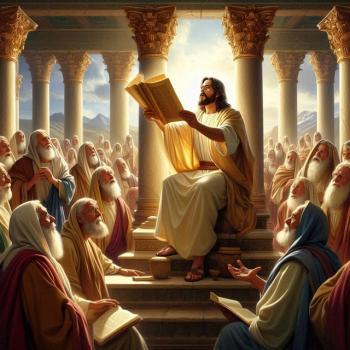This paper is the third and final in a series on the Creeds of the Catholic Church. I have previously expounded on the Apostles and Nicene Creeds. The third is the Athanasian Creed.
In this work, I will provide a history of the Creed and the text itself. Lastly, I will endeavor to analyze the Athanasian Creed.
History And Purpose Of The Creed
The purpose of the Athanasian Creed is to summarize those essential doctrines for salvation affirmed by the church regarding the Trinity. As with the Nicene Creed, it acts as a bulwark against heresies such as Arianism.
The Athanasian Creed
“Whosoever will be saved, before all things, it is necessary that he hold the Catholic Faith. Which Faith except everyone do keep whole and undefiled, without doubt, he shall perish everlastingly. And the Catholic Faith is this that we worship one God in Trinity and Trinity in Unity. Neither confounding the Persons, nor dividing the Substance. For there is one Person of the Father, another of the Son, and another of the Holy Ghost. But the Godhead of the Father, of the Son, and of the Holy Ghost is all One, the Glory Equal, the Majesty Co-Eternal. Such as the Father is, such is the Son, and such is the Holy Ghost. The Father Uncreated, the Son Uncreated, and the Holy Ghost Uncreated. The Father Incomprehensible, the Son Incomprehensible, and the Holy Ghost Incomprehensible. The Father Eternal, the Son Eternal, and the Holy Ghost Eternal, and yet they are not Three Eternals but One Eternal. As also, there are not Three Uncreated, nor Three Incomprehensibles, but One Uncreated, and One Incomprehensible. So likewise the Father is Almighty, the Son Almighty, and the Holy Ghost Almighty. And yet they are not Three Almighties but One Almighty.
So the Father is God, the Son is God, and the Holy Ghost is God. And yet they are not Three Gods, but One God. So likewise the Father is Lord, the Son Lord, and the Holy Ghost Lord. And yet not Three Lords but One Lord. For, like as we are compelled by the Christian verity to acknowledge every Person by Himself to be God and Lord, so are we forbidden by the Catholic religion to say, there be Three Gods or Three Lords. The Father is made of none, neither created nor begotten. The Son is of the Father alone; not made, nor created, but begotten. The Holy Ghost is of the Father, and of the Son neither made, nor created, nor begotten, but proceeding.
So there is One Father, not Three Fathers; one Son, not Three Sons; One Holy Ghost, not Three Holy Ghosts. And in this Trinity, none is afore or after Other, None is greater or less than Another, but the whole Three Persons are Co-eternal together, and Co-equal. So that in all things, as is aforesaid, the Unity in Trinity, and the Trinity in Unity, is to be worshipped. He, therefore, that will be saved, must thus think of the Trinity.
Furthermore, it is necessary for everlasting salvation that he also believe rightly in the Incarnation of our Lord Jesus Christ. For the right Faith is that we believe and confess that our Lord Jesus Christ, the Son of God, is God and Man.”
Analysis Of The Creed
Having provided the text, I will briefly explain the Creed. For that purpose, I have divided the Creed into ten articles.
1) Whoever wants to be saved should, above all, cling to the Catholic Faith. Whoever does not guard it whole and inviolable will doubtless perish eternally.
The word “catholic” means “universal” or “whole,” and therefore refers to the universal Faith of the Catholic Church. To be Catholic and thus be saved, one needs to believe the Creed in its entirety.
2) Now, this is the Catholic Faith: We worship one God in Trinity and the Trinity in unity, neither confusing the persons nor dividing the divine being. For the Father is one Person, the Son is another, and the Spirit is still another. But the deity of the Father, Son, and Holy Spirit is one, equal in glory, co-eternal in majesty.
The Athanasian Creed places a great emphasis on understanding the Holy Trinity. While the three Persons of the Trinity are distinct in their personhood, they exist as one Godhead.
To counter heresies such as Modalism, the Creed clarifies that the three Persons of the Trinity are distinct yet are all equally and eternally God.
3) What the Father is, the Son is, and so is the Holy Spirit. Uncreated is the Father; uncreated is the Son; uncreated is the Spirit. The Father is infinite; the Son is infinite; the Holy Spirit is infinite. Eternal is the Father; eternal is the Son; eternal is the Spirit: And yet there are not three eternal beings, but one who is eternal; as there are not three uncreated and unlimited beings, but one who is uncreated and unlimited.
The Father, Son, and the Holy Spirit are distinct as to their Persons, but they are of the same Divine essence or nature. The Creed points out the fact that the Trinity is uncreated and eternal. In addition, the Trinity as God is infinite; God is not limited by time or space.
4) Almighty is the Father; almighty is the Son; almighty is the Spirit: And yet there are not three almighty beings, but one who is almighty. Thus the Father is God; the Son is God; the Holy Spirit is God: And yet there are not three gods, but one God. Thus the Father is Lord; the Son is Lord; the Holy Spirit is Lord: And yet there are not three lords, but one Lord. As Christian truth compels us to acknowledge each distinct Person as God and Lord, so catholic religion forbids us to say that there are three gods or lords.
This article affirms the quality of omnipotence of all three Persons of the Trinity while restating that there is only one God. The article also confirms the lordship of each member of the Trinity.
The use of the word Lord is significant for several reasons. First, it is intended to show that God has dominion over all creation (which was not true of the pagan gods). Furthermore, by referring to God as Lord, Catholicism equates the Holy Trinity with the God of Israel. The Greek word for Lord (Kyrios) was also used to translate God’s Hebrew name, Yahweh.
5) The Father was neither made nor created nor begotten; the Son was neither made nor created, but was alone begotten of the Father; the Spirit was neither made nor created, but is proceeding from the Father and the Son. Thus there is one Father, not three fathers; one Son, not three sons; one Holy Spirit, not three spirits. And in this Trinity, no one is before or after, greater or less than the other; but all three persons are in themselves, co-eternal and co-equal; and so we must worship the Trinity in unity and the one God in three persons.
God the Father is the uncaused (eternal) cause of creation. The Son is eternally begotten of the Father. The Holy Spirit, too, is eternal and proceeds from the Father and the Son. The article confirms the relational order of the Godhead and the ontological or essential unity of the Trinity.
6) Whoever wants to be saved should think thus about the Trinity. It is necessary for eternal salvation that one also faithfully believes that our Lord Jesus Christ became flesh.
Salvation requires faith in the Triune God. This article stresses the fact that God took to Himself a human nature in the Person of Jesus. Since it is impossible for fallen man to atone for sin, God becomes a human being to reconcile God and man.
7) For this is the true Faith that we believe and confess: That our Lord Jesus Christ, God’s Son, is both God and man. He is God, begotten before all worlds from the being of the Father, and he is man, born in the world from the being of his mother — existing fully as God, and fully as man with a rational soul and a human body; equal to the Father in divinity, subordinate to the Father in humanity.
He is completely one in the unity of his Person, without confusing his natures. For as the rational soul and body are one Person, so the one Christ is God and man.
This article addresses the hypostatic union. In the Person of Jesus, God became a human being while maintaining His Divine nature. “In Him, His divinity is united with His humanity in a real, perfect union without mingling, without commixtion, without confusion, without alteration, without division, without separation.” (See the Common Declaration of Pope of Rome Paul VI and of the Pope of Alexandria Shenouda III).
Although he is God and man, he is not divided but is one Christ. He is united because God has taken humanity into himself; he does not transform deity into humanity.
8) He suffered death for our salvation. He descended into hell and rose again from the dead. He ascended into heaven and is seated at the right hand of the Father. He will come again to judge the living and the dead.
This article reaffirms that Jesus died for our sins. It also affirms that Jesus descended into hell (Sheol in Hebrew). Jesus entered Sheol to free the righteous who had died before Jesus. The article confirms the ascension of Jesus to heaven and His role as the judge of mankind.
9) At his coming, all people shall rise bodily to give an account of their deeds. Those who have done good will enter eternal life; those who have done evil will enter eternal fire.
This article speaks of the physical resurrection and general judgment that will take place at the Second Coming.
10) This is the Catholic Faith: One cannot be saved without believing this firmly and faithfully.
The Creed concludes by stating that salvation is predicated upon the articles of faith articulated by the Creed.
Conclusion
This work completes a series on the Creeds of the Catholic Church. In this paper, I have endeavored to explain the Athanasian Creed.












